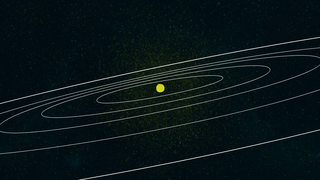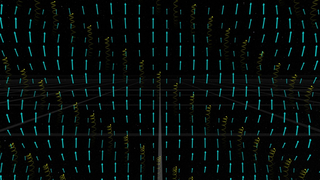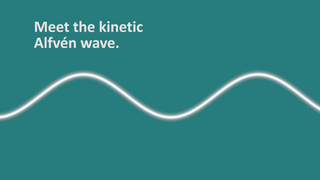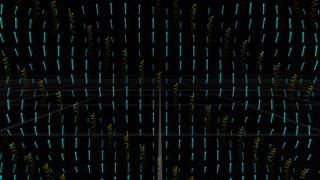Earth
ID: 4560
Most people are familiar with the three states of matter - solid, liquid, and gas. Less known is the fourth state of matter, plasma, when the atoms themselves break down into electrons and ions. Plasmas are actually more common in the universe than the better known solid, liquids and gas, because they tend to exist at temperatures and densities beyond our human experience.
Plasmas exhibit behaviors similar to fluids and gases, but with added complexity of containing magnetic (and occasionally electric) fields. In 1942, Hannes Alfvén combined the mathematics of fluid mechanics and electromagnetism to predict that plasmas could support wave-like variation in the magnetic field, a wave phenomenon that now bears his name, Alfvén waves. This would become the foundational paper for the study of magneto-hydrodynamics, or MHD, for which Alfvén would receive the Nobel prize in 1970.
Since they were hypothesized, Alfven waves have been seen in plasmas on Earth and in space.
Like conventional fluids, plasmas can support waves, but with more variety than in conventional fluids. The waves initially proposed by Alfvén are considered "basic". They have a characteristic that they are compressional, which means that magnetic field variation of the Alfvén waves is in the direction of the wave motion. Charged particles moving through a plasma with these waves have very little alteration of their trajectory. These types of waves are represented in the visualizations below.
But Alfvén waves can exhibit more variety. A variant is the "kinetic" Alfvén wave which is transverse, with strong magnetic field variation perpendicular to the wave motion, so can trade energy between the different frequencies which might propagate through a plasma. This also means it can exchange energy with the particles in the plasma, in some cases, trapping particles in the troughs of the waves and carrying them along. Visualizations of kinetic Alfvén waves are presented at Alfvén Waves - Kinetic.
References/Links
Alfvén Waves - Basic
Plasmas exhibit behaviors similar to fluids and gases, but with added complexity of containing magnetic (and occasionally electric) fields. In 1942, Hannes Alfvén combined the mathematics of fluid mechanics and electromagnetism to predict that plasmas could support wave-like variation in the magnetic field, a wave phenomenon that now bears his name, Alfvén waves. This would become the foundational paper for the study of magneto-hydrodynamics, or MHD, for which Alfvén would receive the Nobel prize in 1970.
Since they were hypothesized, Alfven waves have been seen in plasmas on Earth and in space.
Like conventional fluids, plasmas can support waves, but with more variety than in conventional fluids. The waves initially proposed by Alfvén are considered "basic". They have a characteristic that they are compressional, which means that magnetic field variation of the Alfvén waves is in the direction of the wave motion. Charged particles moving through a plasma with these waves have very little alteration of their trajectory. These types of waves are represented in the visualizations below.
But Alfvén waves can exhibit more variety. A variant is the "kinetic" Alfvén wave which is transverse, with strong magnetic field variation perpendicular to the wave motion, so can trade energy between the different frequencies which might propagate through a plasma. This also means it can exchange energy with the particles in the plasma, in some cases, trapping particles in the troughs of the waves and carrying them along. Visualizations of kinetic Alfvén waves are presented at Alfvén Waves - Kinetic.
References/Links
- Existence of Electromagnetic-Hydrodynamic Waves, Hannes Alfvén (1942)
- The Nobel Prize in Physics 1970
Used Elsewhere In
Related
Visualization Credits
Tom Bridgman (Global Science and Technology, Inc.): Lead Visualizer
Daniel J. Gershman (University of Maryland College Park): Lead Scientist
Genna Duberstein (USRA): Lead Producer
Mara Johnson-Groh (Wyle Information Systems): Lead Writer
Laurence Schuler (ADNET Systems, Inc.): Lead Technical Support
Ian Jones (ADNET Systems, Inc.): Technical Support
Daniel J. Gershman (University of Maryland College Park): Lead Scientist
Genna Duberstein (USRA): Lead Producer
Mara Johnson-Groh (Wyle Information Systems): Lead Writer
Laurence Schuler (ADNET Systems, Inc.): Lead Technical Support
Ian Jones (ADNET Systems, Inc.): Technical Support
Please give credit for this item to:
NASA's Scientific Visualization Studio
NASA's Scientific Visualization Studio
Short URL to share this page:
https://svs.gsfc.nasa.gov/4560
Mission:
Magnetospheric Multiscale (MMS)
Data Used:
Note: While we identify the data sets used in these visualizations, we do not store any further details nor the data sets themselves on our site.
This item is part of this series:
Alfven Waves in Space
Keywords:
SVS >> Magnetohydrodynamics
SVS >> Magnetosphere
SVS >> Plasma
NASA Science >> Earth
SVS >> Particles and Fields
SVS >> Alfven Waves
https://svs.gsfc.nasa.gov/4560
Mission:
Magnetospheric Multiscale (MMS)
Data Used:
ParticleSimulator
ModelThis item is part of this series:
Alfven Waves in Space
Keywords:
SVS >> Magnetohydrodynamics
SVS >> Magnetosphere
SVS >> Plasma
NASA Science >> Earth
SVS >> Particles and Fields
SVS >> Alfven Waves















